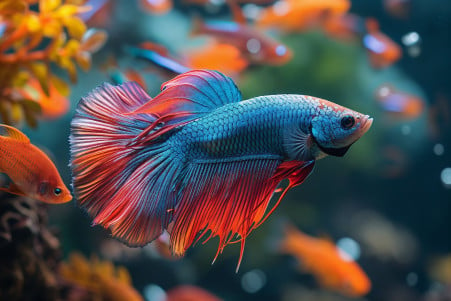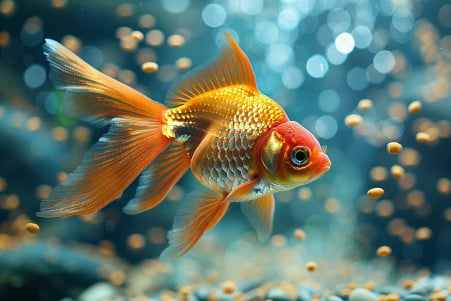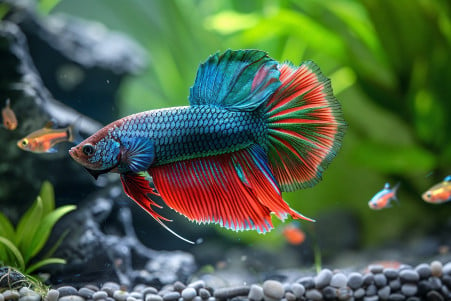Can Betta Fish Live with Goldfish? Understanding Compatibility
7 March 2024 • Updated 6 March 2024

One of the most common questions in the fishkeeping hobby is whether betta fish can be kept with goldfish. Unfortunately, betta fish and goldfish are not compatible tank mates. Not only do they have different temperature requirements, but they also have different dietary needs, with bettas requiring higher temperatures and more protein. Keeping bettas and goldfish together can lead to stress, aggression, and health problems for both species.
This article will explain why betta fish and goldfish can’t be kept together. It will draw on research from ichthyology, animal behavior, and aquarium husbandry to explain the specific environmental and social needs of each species. By the end of the article, you will have a thorough understanding of the factors that impact the well-being of these popular aquarium fish and know how to set up a tank that meets their needs.
Can betta fish live with goldfish?
The Water Temperature Divide: An Important Factor
Knowing the specific water temperature requirements of betta fish and goldfish is important for their well-being. Betta fish need to be in water that’s between 75 and 80 degrees Fahrenheit, which is the temperature of the tropical waters in their natural habitat in Southeast Asia. Meanwhile, goldfish need to be in water that’s between 73 and 75 degrees Fahrenheit (or 23 to 24 degrees Celsius), which is the temperature of the cool, slow-moving waters they prefer.
It’s important for aquarists to keep these temperatures in mind because if they don’t, it can lead to serious health issues for the fish. For example, if the water temperature for goldfish rises above 86 degrees Fahrenheit (or 30 degrees Celsius), it can lead to thermal shock, which can cause symptoms like gasping for air and erratic swimming.
Similarly, if bettas are exposed to temperatures that are outside of their preferred range, it can lead to stress and respiratory infections, which can be deadly.
This means that aquarists need to be diligent about using heaters or other methods to keep the water temperature stable and within the appropriate range. This includes regularly checking the water temperature with thermostats and thermometers to make sure that it’s where it needs to be for the specific type of fish. This level of care is important not only for the fish’s well-being but also for their overall health and lifespan.
Feeding Frenzy: The Dietary Incompatibility
In terms of diet, betta fish and goldfish have very different requirements that can cause major problems if not addressed separately.
According to bettafish.org, betta fish are mostly carnivorous and need a diet that is high in protein, with a preference for live or frozen foods such as mosquito larvae and brine shrimp.
This means that betta fish should be fed a diet of high-protein, commercially-prepared pellets in small quantities to avoid overfeeding and digestive issues. INJAF notes that goldfish are omnivores that lack a stomach and need to eat a diet that includes sinking pellets, green vegetables, and the occasional live food to satisfy their constant grazing.
Keeping betta fish and goldfish in the same tank can lead to food competition and aggression, as bettas are territorial eaters. In addition, if one species eats the other’s food, it can lead to nutritional deficiencies and digestive issues due to the differences in their dietary requirements. Mixed-species tanks also often lead to overfeeding, which can cause poor water quality and health problems such as bloating and constipation.
To ensure that both bettas and goldfish have a healthy diet, it’s important to meet their different feeding schedules and food preferences. The best way to make sure that both bettas and goldfish are getting the nutrition they need without conflict is to feed them separate, species-appropriate diets in separate tanks.
Navigating Space for Finned Friends: Betta and Goldfish Housing
One of the most important things to consider when setting up a tank is the size of the environment. Betta fish need at least a 5-gallon tank to be happy and healthy, according to FishLab. This size tank will give them enough room to act naturally and not feel confined, which can lead to a shorter life.
Goldfish need even more space. Fancy goldfish need a tank with a large footprint to accommodate their body shape and swimming style, while common goldfish need a tank that’s long enough to turn around and swim in, according to INJAF.
Overcrowding can lead to stress and health problems like stunting and aggression. If the tank is too small, it can be difficult to maintain good water quality, which can lead to more stress and illness.
To make sure that the tank is a good place for your fish to live, it’s important to make sure that the tank is big enough and that the filter is good enough to keep the water clean, as the About Goldfish website points out.
The general rule of thumb for goldfish tanks is to start with a 20–gallon tank for the first fish and add 10 gallons for each additional fish. On the other hand, betta fish tanks should be at least 5 gallons, with longer tanks being better for the fish’s swimming habits. Following these rules will help make sure that each species is in an environment that’s right for them, which will help them be healthier and happier.
Behavioral Differences: Betta vs. Goldfish
Betta fish, native to Southeast Asia, are known for their territorial behavior. Also known as Siamese fighting fish, male bettas are especially aggressive toward other males and other fish that look like them. When kept in a community tank, their territorial behavior can lead to stress and aggression.
On the other hand, goldfish, which come from East Asia, are known for their social behavior and can live with other non-aggressive fish. The different behaviors of bettas and goldfish mean that they are not compatible tank mates.
When kept in a community tank, bettas are more likely to be aggressive and bully other fish they see as competitors, which can lead to more attacks. This is especially true when a betta sees fancy goldfish with their bright colors and flowing fins, which can look like another male betta, according to Hepper.
In contrast, common goldfish, which are fast swimmers and can grow quite large, may intimidate or even attack the slower and more delicate betta.
Aquarists need to understand these behaviors to effectively manage their tanks. The clear tendency for territorial behavior and aggression between bettas and goldfish makes it important for aquarists to keep them in separate tanks to avoid conflict and ensure the health and well-being of both species. It’s important to meet their needs based on their natural behaviors to create a successful tank community.
Building Better Homes: How to Take Care of Betta Fish and Goldfish
Because of their different needs, betta fish and goldfish cannot be kept in the same tank. Betta fish require a minimum of a 5-gallon tank to thrive, according to Bettaboxx, so that they can exhibit their natural behaviors without feeling cramped. Meanwhile, goldfish need even larger tanks, and The Aquarium Life recommends using high-quality thermostats to maintain a consistent temperature in the tank to avoid problems like thermal shock.
In addition to keeping an eye on the temperature, goldfish owners also need to make sure that the water stays below 86 degrees Fahrenheit, as goldfish are particularly sensitive to high temperatures.
Dr. Jessie Sanders notes that the feeding schedule should be adjusted based on the temperature of the water to ensure that it lines up with the fish’s metabolism. This means that goldfish tanks should be kept cooler, while betta tanks should be kept warmer, to make sure that their needs are met and that they don’t develop any health problems.
When it comes to behavior, stress and aggression can be reduced by making sure that the tank is set up in a way that provides plenty of space and environmental enrichment.
Meanwhile, the needs of each fish can be met by making sure that the tank is set up to cater to their species-specific requirements, from their diet to their decor. By doing this, fish owners can ensure that each fish has a healthy, stress-free life.
How to Build a Successful Aquarium: A Recap
Betta fish and goldfish are not compatible tank mates because of their vastly different needs. From differences in preferred water temperatures and dietary needs to space requirements and even behavioral traits, there are many reasons why these two species should not be kept together. Separate tanks are necessary to avoid stress and aggression, which are important for the overall well-being of these fish.
This is why it’s so important to understand and appreciate the unique needs of each species. This is the key to being a responsible aquarium owner. It means making sure that betta fish are kept in warm, protein-based environments and that goldfish are kept in cooler water and fed a diverse, omnivorous diet. Tank size is also important as it can help prevent the negative impacts of overcrowding.
In the end, it’s important to make sure that you’re creating stress-free environments that are tailored to the specific needs of betta fish and goldfish. Not only will this ensure that they are healthy, but it will also make the experience of owning an aquarium more rewarding. With the right care, each fish can show off its beautiful colors and unique personality, adding life and happiness to their underwater worlds.


